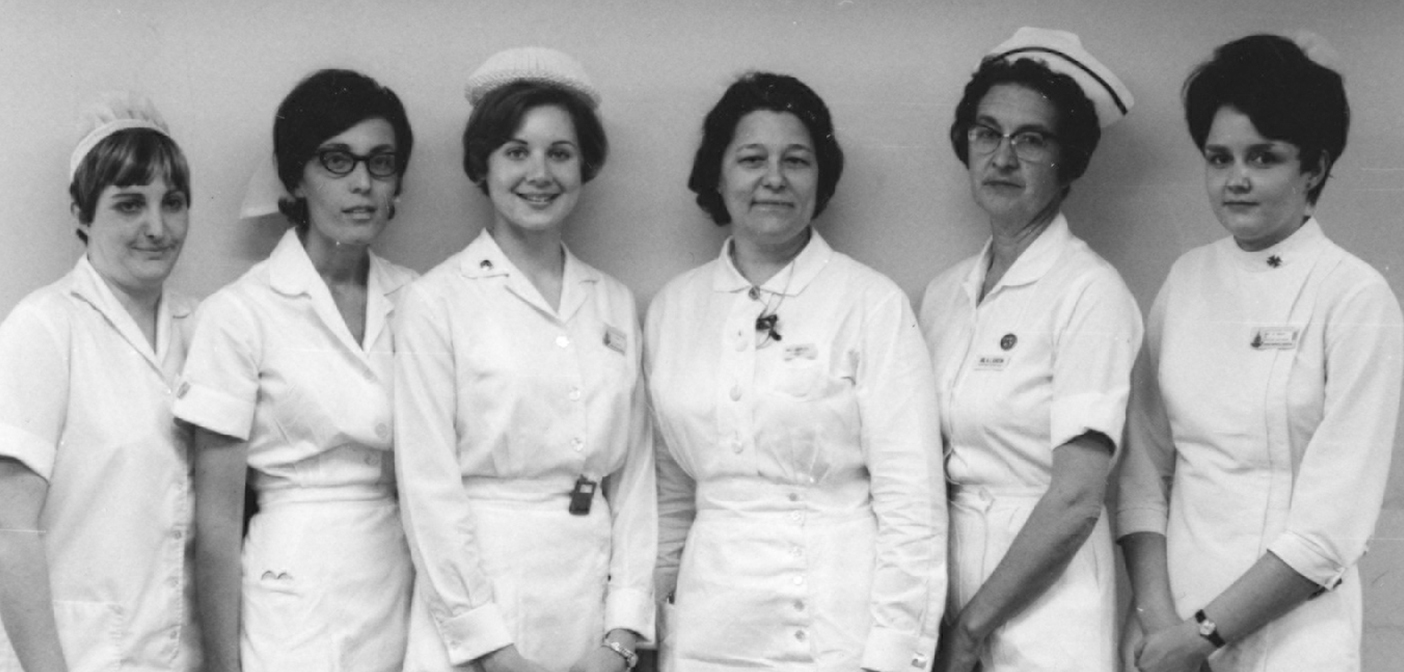Trailblazer’s spirit remains as radiology nursing specialty thrives
Today, radiology nursing is a thriving specialty at The Johns Hopkins Hospital and a vital link in the chain of care throughout the Department of Radiology and Radiological Science. The department’s nursing staff is deployed throughout 10 imaging divisions, working closely with technicians and physicians in a fast-paced and constantly evolving environment. Radiology nurses are innovators and problem solvers, encouraged to take initiative to find ways to improve procedures and patient care.This pioneering spirit in the culture of radiology nursing at Hopkins is the legacy of a woman who was influential in shaping it from its earliest days—the late Charlotte Linton Godwin, RN, one of Hopkins’ first radiology nurses. From the time she joined the Diagnostic Division in 1948 to her tenure as director of nursing services in the Diagnostic Radiology and Charlotte Linton Godwin, fourth from left, was driven to advance radiological nursing practice.Radiological Services Division from 1977–1987, Godwin was driven to refine the role of the nurse within the radiological care team and to consistently advance radiological nursing practice.
Hopkins Hospital launched its Radiation Department in 1935 with a staff of six that included one nurse, Helen Slade, RN. Her duties were general bedside care and coordination of care among the team. By the time Godwin was hired in 1948, there were just two nurses and one nursing assistant, and the nursing staff also helped in the preparation of supplies and assisted with procedures. Almost immediately, Godwin seized opportunities for change, creating a nursing training class for technicians that led to improved patient satisfaction.
By the 1950s, as the department grew, so did nurses’ responsibilities. Godwin helped to reorganize workflows as the staff increased, relieving nurses of administrative tasks so they could focus instead on patients and participate in procedures and research. Through the end of the decade and into the early ’60s, Godwin successfully campaigned to bring operating room protocols to the Cardiovascular Diagnostic Lab’s procedures, developed patient education materials, and worked with the staff on orientations and technology training sessions. Her efforts focused not only on the expertise of the radiology nurses but also their own safety. Among improvements, for example, was the testing and purchase of restraints for pediatric X-rays that eliminated the need for nurses to hold children during the procedure.This pioneering spirit in the culture of radiology nursing at Hopkins is the legacy of a woman who was influential in shaping it from its earliest days.Working with Carolyn Weinberg, RN, in Nuclear Medicine to conduct an extensive study of patients and staff, Godwin led a move to give nurses more time and materials to explain procedures and prepare patients for what to expect, leading to much higher patient cooperation and satisfaction.Godwin encouraged her nursing staff to take leadership roles on committees and orientations throughout the hospital. At the request of the Joint Commission of Accreditation of Hospitals in 1979, she presented a Radiology Nursing manual that serves as the basis for the one in use today. With Hopkins’ support, she organized a meeting for nurses at the Radiological Society of North America’s Scientific Assembly in November of 1981 that laid the foundation for the Association for Radiologic & Imaging Nursing (ARIN), of which Godwin was elected the first president. (Her protégé, Ron Wardrope, RN, CRN, of Pediatric Radiology at Hopkins, was named ARIN’s Nurse of the Year in 2012.)
As a result of Godwin’s work and influence, Radiological Nursing at Hopkins transformed from a general bedside and administrative role to a dynamic, multifaceted specialty that encourages autonomy and initiative. Radiology nurses draw on advanced skills to administer and track medications, perform patient assessments, and respond to emergencies. They are educators both to patients and to staff within and outside their units and are highly involved with committees and initiatives throughout Hopkins. They are those change makers who, in the words of ARIN’s Core Values, “lead with humility; follow with urgency.”
